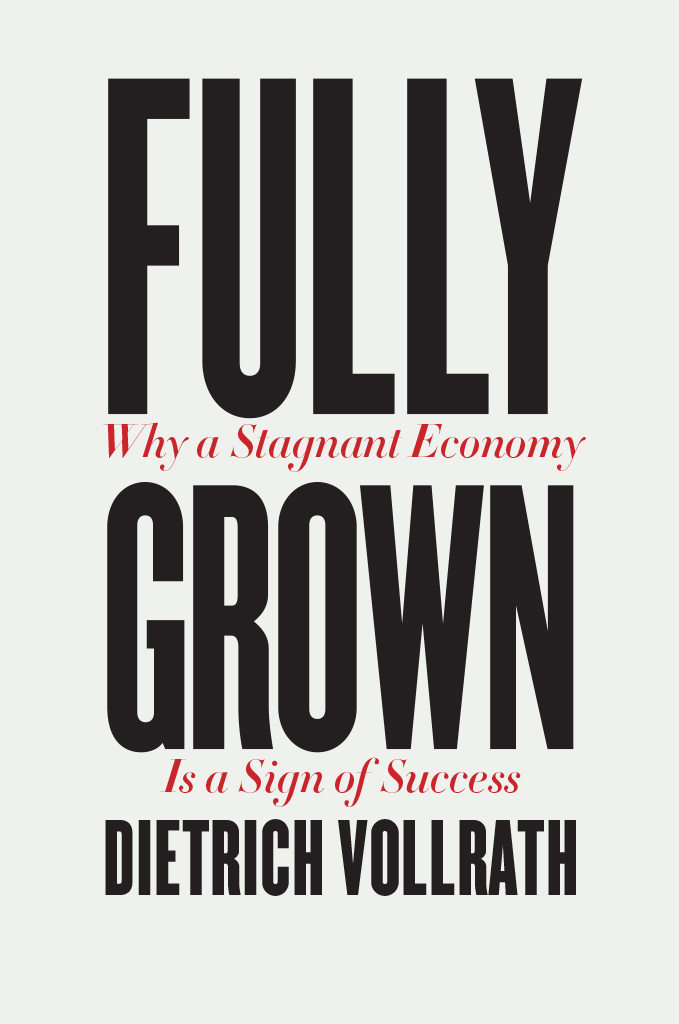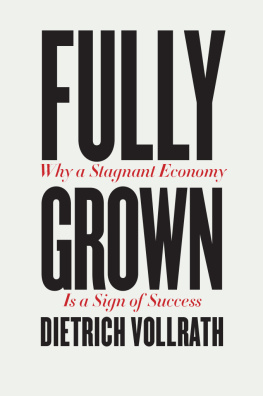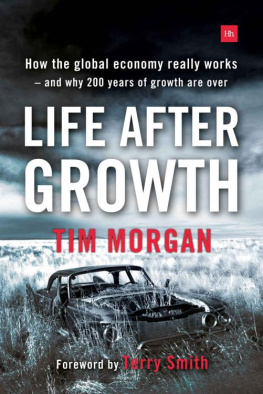
Fully Grown
Fully Grown
Why a Stagnant Economy Is a Sign of Success
Dietrich Vollrath
The University of Chicago Press Chicago and London
The University of Chicago Press, Chicago 60637
The University of Chicago Press, Ltd., London
2020 by The University of Chicago
All rights reserved. No part of this book may be used or reproduced in any manner whatsoever without written permission, except in the case of brief quotations in critical articles and reviews. For more information, contact the University of Chicago Press, 1427 E. 60th St., Chicago, IL 60637.
Published 2020
Printed in the United States of America
29 28 27 26 25 24 23 22 21 20 1 2 3 4 5
ISBN-13: 978-0-226-66600-6 (cloth)
ISBN-13: 978-0-226-66614-3 (e-book)
DOI: https://doi.org/10.7208/chicago/9780226666143.001.0001
Library of Congress Cataloging-in-Publication Data
Names: Vollrath, Dietrich, author.
Title: Fully grown : why a stagnant economy is a sign of success / Dietrich Vollrath.
Description: Chicago : The University of Chicago Press, 2020. | Includes bibliographical references and index.
Identifiers: LCCN 2019024282 | ISBN 9780226666006 (cloth) | ISBN 9780226666143 (ebook)
Subjects: LCSH: Economic developmentUnited States. | Economic developmentTechnological innovations. | Economic developmentEconometric models.
Classification: LCC HC110.E44 V65 2019 | DDC 330.973dc23
LC record available at https://lccn.loc.gov/2019024282
 This paper meets the requirements of ANSI / NISO Z39.48-1992 (Permanence of Paper).
This paper meets the requirements of ANSI / NISO Z39.48-1992 (Permanence of Paper).
Contents
At the turn of the millennium in 2000, you could be forgiven for thinking that stable economic growth was something like a law of nature. The average growth in the late 1800s, when the US economy was dominated by agriculture, was about 2% per year. Between 1900 and 1950, as the United States turned into an industrial powerhouse, the average growth was also 2%. For the rest of the twentieth century, the average growth rate was 2%. This is true despite all the fluctuations and changes that occurred in the economy over this time, including the Great Depression, two world wars, globalization, high tax rates, low tax rates, and the arrival of electricity, air travel, and computers. A lot of economic theory, and practical policy, was built around the fact that growth always averaged out to about 2% per year.
Always, that is, until now. For nearly two decades, the average growth rate of per capita gross domestic product (GDP) has been around only 1%, half of what several generations of Americans experienced in the past. It has been going on too long to be just a temporary blip, and it has forced economists and policy makers to recalibrate their expectations of how fast the economy will grow in the future.
At the same time, if you didnt know growth had slowed down but instead focused on the level of material living standards, you wouldnt guess there was a problem. Real GDP per capita, our way of assessing the value of the goods and services produced in the economy, was roughly 20% higher in 2018 than in 2000. It was more than three times higher than in 1950, more than eight times higher than in 1900, and more than fifteen times higher than in 1870, which is as far back as we can track. So what gives? Does this mean that the growth rate doesnt matter?
Noit matters. But the drop in growth isnt what you think. In this book, Im going to share the surprising story of why growth slowed downand why thats a good sign.
I wish there were a nifty anecdote about how I hit upon this idea, an aha! moment in the shower or a pointed conversation with a cab driver. The truth is that there isnt. I sort of stumbled into this project over the course of the past few years. In 2011, Charles (Chad) Jones asked me to collaborate on a new edition of his undergraduate textbook on economic growth. At that point, I was mainly focused on my research related to long-run growth and population change, which was something Chad was hoping to incorporate. But he also was hoping to update the books material on theories of innovation, and to bring the data on growth rates and living standards up to date. As I worked on the book and then started teaching from an early draft of it, I found that I had accumulated a set of stories, data, and math that was useful in explaining topics in economic growth, and not all of it could find its way into the textbook.
As others started using the book, I realized that I could share some of that additional material I had and perhaps make adopting the book more attractive to others. So in the spring of 2014 I started publishing the very unimaginatively named Growth Economics Blog. I posted ideas about how to explain or understand simple concepts in economic growth and started commenting on current research. Although the blog did not become an overnight sensation, there turned out to be a decent audience of people interested in topics related to growth.
One topic in particular that drew a lot of readers was the growth slowdown, which in 2014 was becoming noticeable in the aftermath of the financial crisis. The interest in that was mirrored in the courses I was teaching, and I started to dig more into the underlying reasons why growth had not accelerated as expected after the recession that crisis caused. It was around that same time that I read some research by John Fernald, who established that the growth slowdown was not just a result of the recession; rather, it was a long-run phenomenon that started around the turn of the twenty-first century.
At the same time, more and more stories were coming out regarding the growth slowdown, and a trope in those stories was a failure of innovation. Most of this was just angry-old-man ranting about how the kids with their FaceTweets were ruining the economy, as far as I could tell. It also confused the notion of productivity, which Ill define clearly in this book, with technology. I ended up writing a number of posts about how productivity growth had slowed down, but that this might reflect not a failure of technology but rather changes in the market power of firms and the shift of economic activity between sectors.
Because of some of my own research on historical shifts of workers out of agriculture, I was also playing around with data and theories related to the industrial composition (e.g., manufacturing, health care, retail) of what we produce. That got me reading more deeply the work of William Baumol, his cost disease of services, and its plausible role in slowing down economic growth.
Reading Baumol may have been the point at which I first conceived of writing a book about the subject of the growth slowdown. I had acquired a lot of disparate material on the subject, and I thought I saw some common threads running through all of it. First there was the notion that productivity growth had more to do with how we allocate our workers and capital across different activitiesfirms or industriesthan with technology per se. Second was the idea that an increase in market power may be a reasonable explanation for why those allocations changed so much over time.
As I started to work on the outlines of that book, though, I realized that my original concept of the growth slowdown was not going to hold up. Some simple accounting showed me that I had entirely underestimated the role that demographic changes played, and that a story based just on productivity growth would be something of a waste of time. I also was absorbing research on the influence of market power on growth and realized it was far more subtle than I had originally thought. Both things left me wavering about whether it was worth it to continue to work on a book. I had all these bits and pieces of explanations for the growth slowdown, but they didnt seem to fit together.
Next page







 This paper meets the requirements of ANSI / NISO Z39.48-1992 (Permanence of Paper).
This paper meets the requirements of ANSI / NISO Z39.48-1992 (Permanence of Paper).